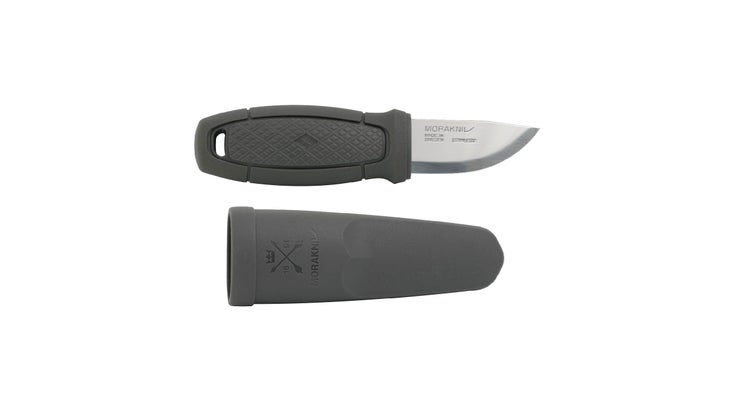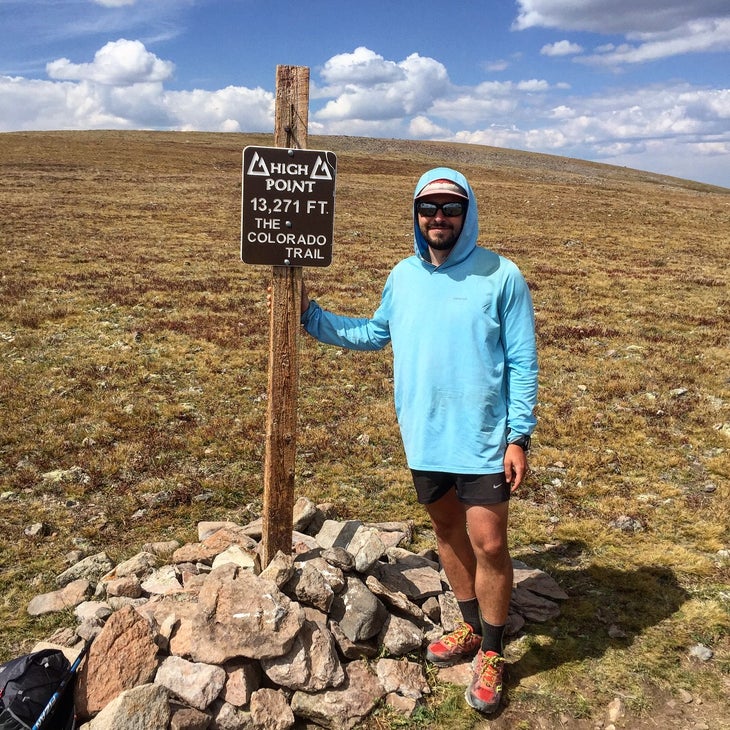Products You May Like
Receive $50 off an eligible $100 purchase at the Outside Shop, where you’ll find gear for all your adventures outdoors.
Sign up for Outside+ today.
For many hikers, backpacking knives are mostly used for slicing cheddar and chopping onions. But like the rest of your emergency gear, from a survival blanket to a gear patch kit, when you need a knife, you really need it. Not a knife aficionado? Fear not. This list covers a range of types, uses, and price points, and will help you pick the best knife for your backpacking style.
What to Look For in a Backpacking Knife
Fixed or Folding?
The biggest question for any backpacker in search of a new blade is choosing between folding knives—made with moving parts to open and close the blade from the handle—and fixed blade knives—typically a single piece of steel or carbon fiber kept in a sheath. Folding knives are, on average, lighter and occasionally come in multi-tool bundles that are helpful for some, but offer too much for others. Fixed blades are heavier and less compact, but are stronger and tend to last longer. In emergency situations, a heavy fixed blade has an added benefit of being able to split wood for a fire.
Blade shape
A drop point blade (a convex curve following a straight spine) is the most common shape among backpackers for good reason—its utilitarian slope is more versatile and keeps the blade cleaner than the sharp angles of a tanto, and is less likely to break (or accidentally cut you) than a clip point. Unless you are climbing or packrafting—which potentially involve cutting ropes in unstable positions, the domain of a sheepsfoot blade—or hunting on your backpacking trip, a drop point blade is probably the one for you.
Accessibility
Folding knives sometimes come with one-handed or assisted openings to make it easier to release the handle (very helpful when you have your hands full.) They can be more expensive and dangerous if you’re not careful, but many folding knives also include a lock to prevent the blade from folding in on itself.
Ultimately, consider how you’re most likely to use a knife on your adventures. If you’re a camp chef and whittler around the campfire, or you want to be prepared for a greater range of survival situations, a folding knife won’t serve you as well as a heavier fixed blade. If you’re looking to add more function but less weight to your ultralight kit, consider a compact folding knife.
—Kevin Johnson
Best Backpacking Knives on the Market

Best Folding Backpacking Knife: Kershaw Atmos 4307
Price: $63
Weight: 1.9 oz.
Buy Now
When a knife this light hangs tough for a 2,650-mile thru-hike, it’s a keeper. Our tester used the Atmos almost every day on the Pacific Crest Trail. Credit the locking mechanism, which uses a thin strip of steel riveted to the interior of the handle; it keeps the 3-inch blade stable when open, but without the bulk and weight of traditional liner construction. The handle, made with fiberglass, cloth, and carbon-fiber composite, also shaves weight while remaining tough and easy to handle. “The steel blade kept its edge for a long time before it needed sharpening,” our thru-hiking tester says, “even after I used it to cut slits in my shoes to relieve hot spots.” —Justine La Vigne

Best Fixed Blade Backpacking Knife: Buck Selkirk
Price: $79
Weight: 7.6 oz.
Buy Now
If you want a knife that can do a lot more than just whittle, pick up the fixed-blade Selkirk. Its 4.6-inch, full-tang steel blade with a thicker-than-average point excels at heavier tasks. One wildland firefighter praised its weight-to-function ratio after he used it to tear through thickets of alders and thorn bushes. The Selkirk’s plastic-composite handle proved equally durable when we pounded in tent stakes with the butt end, and the grippy material kept our sweaty hands from slipping. “Even though this knife is bombproof, I was able to use it for delicate tasks such as fileting a cutbow trout,” reports our firefighter tester. —J.L.V

Best Value Backpacking Knife: Morakniv Eldris LightDuty
Price: $24
Weight: 5 oz. (including sheath)
Buy Now
Our tester had doubts when he unboxed this diminutive knife, but by the end of the testing cycle he was singing its praises. The Eldris LightDuty’s 2.3-inch blade is constructed of Swedish stainless steel and proved ideal for carving tinder from hardwood in Virginia’s Mt. Rogers National Recreation Area. Our tester found that the blade’s spine is thick enough to spark a ferro rod (not included), a rare quality in a knife this size. A rubber handle coating gripped well in his hand as he gutted rainbow trout in the Linville Gorge Wilderness, North Carolina, and the knife rinses and wipes off easily; it shows no signs of rust after four-plus months. Bonus: We don’t often highlight sheaths, but we have to give props to the polymer one included with the Eldris LightDuty; its smooth draw action makes the knife exceedingly easy to access, and it holds tight the rest of the time. —J.L.V

Best Lightweight Backpacking Knife: SOG Ultra XR
Price: $130
Weight: 1.2 oz.
Buy Now
The Ultra XR is one of the slimmest and most compact knives we’ve ever used. SOG upgraded the original version with a higher-quality stainless steel that prolongs the 2.8-inch blade’s edge without sharpening and resists chipping and corrosion. During six months of use, which included cutting kindling, food prep, and box opening, the Ultra XR never dulled and proved adept at detailed work. An XR lock (SOG’s proprietary mechanism) allows single-handed opening, and doesn’t budge under up to 1,500 pounds of pressure (so claims the product manual; we leaned hard on it without feeling it flex). The carbon-fiber handle is thin (6.5 millimeters) but provides a comfortable grip, and the pocket clip doubles as a credit card and cash holder. —J.L.V

Best Backpacking Knife with Bonus Features: Gerber Suspension-NXT
Price: $39
Weight: 6.7 oz.
Buy Now
Buying a full-featured multitool typically means shelling out about $100. Not the Suspension-NXT: At $37, this is the most affordable one we’ve used that also has a robust toolset and a secure locking mechanism. Our tester carried the Suspension-NXT for a week on the Appalachian Trail and says it never failed him, even when he pushed it beyond normal use. “I attached my bear hang rope to the lanyard hole in the tool to throw it up and over a branch, and after hitting the ground with some force, I was surprised it was in one piece,” he says. He also praised the coarseness of the file for paring down a piece of plastic that was sticking out of his boot, and the beefy spring-loaded pliers and scissors that came in handy for restringing a tent pole. Ding: The tools are a bit difficult to open one-handed. —J.L.V
What a Backpacker Editor Looks For in a Backpacking Knife

Benjamin Tepler, Assistant Gear Editor
“When it comes to knives, I’m a minimalist. I have a small, foldable scissors for cutting bandages or patches. I rarely hunt or fish on backpacking trips, so that leaves me with the basics: food prep, cutting cord, and emergency kindling. When I pack a knife, I want it to be lightweight, compact, and durable. That means buying the highest quality stainless steel I can afford, which holds an edge well and resists rusting and corrosion better than a high-carbon steel blade.”
How to Maintain a Backpacking Knife
Keep it clean. Let grit build up in your knife’s hinge and it can negatively impact the blade or even stick it closed. Blow it out with compressed air, then clean out the blade and the folding mechanism with rubbing alcohol and cotton swabs. Periodically you’ll need to take apart your knife (most use tiny Torx screws) to give it a more detailed cleaning. Lubricate it with mineral oil or another neutral lubicant to help it fold smoothly and avoid rust.
Keep it sharp. Blade gone dull? There are a lot of ways to get your edge back. The least complicated: a whetstone or even a flat river rock. Have access to a power outlet and some extra cash? A tool like the Work Sharp Ken Onion Edition Knife and Tool Sharpener can sharpen your blade in a jif. Most people will want something in the middle: the Lansky C-Sharp is light enough to carry with you, but easier to use than a whetstone, which has a bit of a learning curve. —Adam Roy
